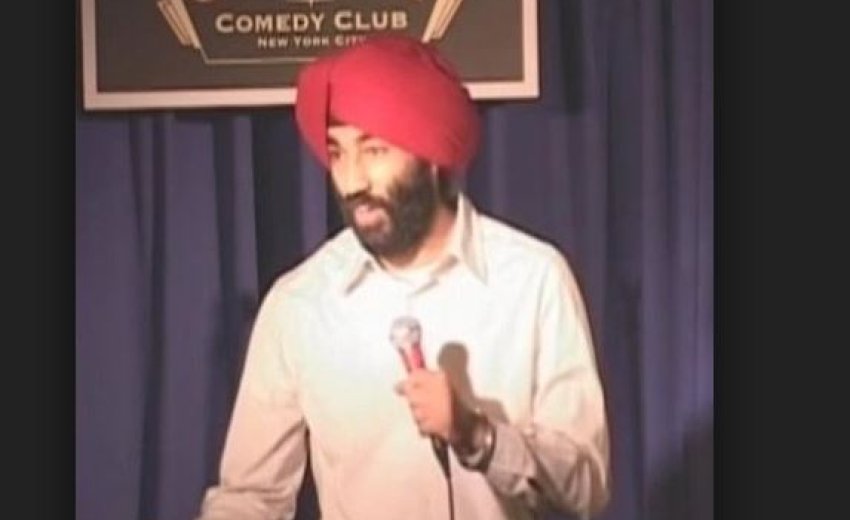A sign in the back of the comedy club boasted that many of the comics who performed there had also appeared on Letterman and Leno. It was "new talent" night, and I watched people quickly fill the seats. As the show progressed, I was worried that I might be heckled— especially by a group of rowdy boys who laughed sarcastically when jokes failed. When their comedian friend took the stage, some of them got up and roared. I wasn't sure how I would handle the crowd if they shouted over me. When the comic stepped down from the stage, his friends kept yelling his name, even when the emcee tried to tell a joke. The emcee didn't command any authority. He waited for them to calm down before he introduced me: "Our next comic is very funny. He's a regular American, a slice of Middle America, someone who came right out of 'Leave It to Beaver'."
The emcee didn't command any authority. He waited for them to calm down before he introduced me: "Our next comic is very funny. He's a regular American, a slice of Middle America, someone who came right out of 'Leave It to Beaver'."
I tried to take the mike off the stand, but pulled it so hard that the stand toppled over. I caught it just in time and began right away: "Let me explain the turban." I pointed to my head, paused for a second, and widened my eyes and let them roam around the room. "I just came back from an extreme makeover! "When they laughed, I quickly added, "And maaaaan, do I look sexy!"
It didn't go at all smoothly when I began performing stand-up comedy. The slicing sounds of silence in response to my jokes felt emasculating. Afterward, my friends told me that I had rushed my material, and that I was too mild, defanged almost.
I began doing stand-up to educate my fellow Americans about my religion. I wanted to show that Sikhs were not fanatical Muslims. I laced jokes with facts conveying that 99 percent of people with turbans in America were Sikhs, that Sikhism started in India 500 years ago and was now the fifth largest religion in the world. We believed in one God and equality for all, regardless of race, color, gender, religion and caste. But I was not funny.
I started reading books on stand-up comedy. After performing on each new-talent night, I stayed till the end to watch other comics and studied the audience to see how each age group reacted differently. At home I watched professional comedians on Comedy Central for hours and changed my material, making it more biting and provocative.
"A lot of people ask me why I wear a turban," goes one of my jokes. "I tell them it's because it contracepts my vices. But you know what, turbans are great contraceptives … I haven't had sex in five years!"
I became more ambitious. I now wanted to show the entire audience that Indians, Muslims or brown people in general were affable and moderate. Because I received my first couple of threats from Sikhs, I had to convince myself that my fellow Sikhs were in fact also moderate. But it felt strangely exciting reading the verbal barbs posted on my first YouTube clip: I was having an impact.
I e-mailed some of the overzealous Sikhs and told them that I was making fun of prejudice against those who wear turbans, not the turban itself, which seemed even more sacred now. After 9/11, many Sikhs had cut their hair and stopped wearing turbans. The menacing looks and discrimination were too much. Our visible identity in numbers was dwindling in both America and India. Bollywood films had reduced Sikhs to fools and caricatures. In America we were being taken too seriously; in India, not enough. It sometimes made me feel compelled to conform and fit in, too.
But I realized that Sikh symbols, like the turban, were important, just as all religious symbols are. And a symbol can no more be destroyed by humor than a word's meaning can be torn by a paper shredder. The only thing one had to worry about was mitigating one's faith, the act of countering darkness with bare-knuckle punches.
Yet religious symbols don't always serve as a catalyst for truthful living. Wearing one for the sake of wearing it reduces religion to superstition. Sikh society and many others in India remain divided by tribalism, female infanticide and gender discrimination. So many take the religious symbols as garbs and amulets of salvation alone, rather than as a palette to paint understanding and soften the edges.
Still, I completely understood my fellow Sikhs' sensitivity and their fear of being marginalized further. I really didn't mind the death threats and the heckling, as long as I continued not having sex.
Singh lives in Williston Park, N.Y.
© 2008
